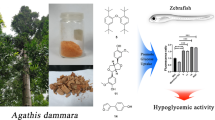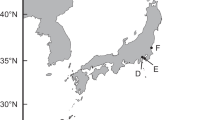Abstract
Methanol extracts of freshly harvested cells of the marine diatom Phaeodactylum tricornutum were found to produce a feeding deterrent effect in the copepod Tigriopus californicus. Bioassay guided fractionation of the methanol extracts led to the isolation of four compounds possessing feeding deterrent activity. The compounds were identified as apo-10′-fucoxanthinal (1), apo-12′-fucoxanthinal (2), apo-12-fucoxanthinal (3), and apo-13′-fucoxanthinone (4) by detailed spectroscopic analysis and comparison with authentic compounds produced semi-synthetically from fucoxanthin. Compounds 1 to 4 exhibited feeding deterrent responses in T. californicus at concentrations of less than 20 ppm.
Similar content being viewed by others
References
Berges JA, Virtanen C (1993) Expanding the capabilities of laboratory instruments using built-in microprocessors and serial interfaces: adapting and LKB Ultraspec II UV spectrophotometer for scanning and enzyme kinetic analyses. Computers Biol Med 23: 131–141
Bonnett R, Mallams AK, Spark AA, Tee JL, Weedon BCL, McCormick A (1969) Carotenoids and related compounds. Part XX. Structure and reactions of fucoxanthin. J chem Soc C 3: 429–454
Egloff DA (1986) Effects of Olisthodiscus luteus on the feeding and reproduction of the marine rotifer Synchaeta cecilia. J Plankton Res 8: 263–274
Hansen PJ (1989) The red tide dinoflagellate Alexandrium tamarense: effects on behaviour and growth of a tintinnid ciliate. Mar Ecol Prog Ser 53: 105–116
Harrison PJ, Waters RE, Taylor FJR (1980) A broad spectrum artificial seawater medium for coastal and open ocean phytoplankton. J Phycol 16: 28–35
Haugan JA, Liaaen-Jensen S (1989) Improved isolation procedure for fucoxanthin. Phytochem 28: 2797–2798
Huntley M, Sykes P, Rohan S, Marin V (1986) Chemically mediated rejection of dinoflagellate prey by the copepods Calanus pacificus and Paracalanus parvus: mechanism, occurrence, and significance. Mar Ecol Prog Ser 28: 105–120
Ianora A, Poulet SA, Miralto A (1995) A comparative study of the inhibitory effect of diatoms on the reproductive biology of the copepod Temora stylifera. Mar Biol 121: 533–540
Ives JD (1987) Possible mechanisms underlying copepod grazing responses to levels of toxicity in red tide dinoflagellates. J exp mar Biol Ecol 112: 131–145
Lux H (1965) Barium manganate (VII). In: Brauer G (ed) Handbook of preparative inorganic chemistry. Academic Press, New York, NY, p 1462
Meinwald J, Erickson K, Hartshorn M, Meinwald YC, Eisner T (1968) Defehsive mechanisms of arthropods. XXIII. An allenic sesquiterpenoid from the grasshopper Romalea microptera. Tetrahedron Lett 25: 2959–2962
Shaw BA, Harrison PJ, Andersen RJ (1994) Evaluation of the copepod Tigriopus californicus as a bioassay organism for the detection of chemical feeding deterrents produced by marine phytoplankton. Mar Biol 121: 89–95
Shaw BA, Harrison PJ, Andersen RJ (1995) Feeding deterrence properties of apo-fucoxanthinoids from marine diatoms. II. Physiology of production of apo-fucoxanthinoids by the marine diatoms Phaeodactylum tricornutum and Thalassiosira Pseudonana and their feeding deterrent effects on the copepod Tigriopus californicus. Mar Biol 124: 473–481
Sullivan DS, Bisalputra T (1980) The morphology of a harpacticoid gut: a review and synthesis. J Morph 164: 89–105
Sykes PF, Huntley ME (1987) Acute physiological reactions of Calanus pacificus to selected dinoflagellates: direct observations. Mar Biol 94: 19–24
Taber DF (1982) TLC mesh column chromatography. J org Chem 47: 1351–1352
Targett NM, Ward JE (1991) Bioactive microalgal metabolites: mediation of subtle ecological interactions in phytophagous suspension-feeding marine invertebrates. Bioorg mar Chem 4: 91–118
Uye S, Takamatsu K (1990) Feeding interactions between planktonic copepods and red-tide flagellates from Japanese coastal waters. Mar Ecol Prog Ser 59: 97–107
Ward JE, Targett NM (1989) Influence of marine microalgal metabolites on the feeding behavior of the blue mussel Mytilus edulis. Mar Biol 101: 313–321
Wolfe S, Ingold CE (1983) Oxidation of organic compounds by zinc permanganate. J Am chem Soc 105: 7755–7757
Author information
Authors and Affiliations
Additional information
Communicated by R.J. Thompson, St. John's
Rights and permissions
About this article
Cite this article
Shaw, B.A., Andersen, R.J. & Harrison, P.J. Feeding deterrence properties of apo-fucoxanthinoids from marine diatoms. I. Chemical structures of apo-fucoxanthinoids produced by Phaeodactylum tricornutum . Marine Biology 124, 467–472 (1995). https://doi.org/10.1007/BF00363921
Received:
Accepted:
Issue Date:
DOI: https://doi.org/10.1007/BF00363921




